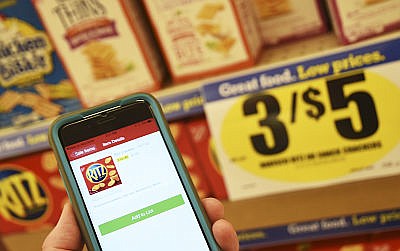With the use of smartphones increasing rapidly over the past few years, businesses are trying to find new ways to reach out to customers and gain their loyalty.
Customer loyalty programs are still an essential marketing and advertising strategy for both large corporations and mid- to small-level businesses. But with customers always on the go and buying more and more smartphones by the day, how can businesses keep up?
Rewards make everyone happy (including business owners)
According to a 2015 study by Experian, three out of four U.S. companies with loyalty programs generate a return on investment and 69 percent of U.S. companies with loyalty programs tracked that the average lifetime value for each customer was $1,803. This shows businesses can greatly benefit from loyalty programs, and it's worthwhile to invest.
For Jefferson City Hy-Vee Store Director Rod Dolph, having the Fuel Saver + Perks program has been an essential tool to compete against other grocery stores and supercenters around Jefferson City.
"As competitive as the grocery business is, I think (the Fuel Saver Card) sets us apart and helps drive business because no one can compete against us," Dolph said.
With so much competition, stores have to stay ahead of the advertising game and pay attention to how customers shop, when they purchase products and what attracts customers to their store.
Almost all businesses are using some type of membership or reward program to entice customers to keep coming back. Businesses from small coffee shops and grocery stores to pharmacies like Walgreens and CVS are using loyalty programs.
For example, at grocery stores like Hy-Vee and Gerbes, customers can gain "fuel points" just by buying select "gas or fuel saver" items in store. As those points accumulate, customers can save money when filling up at the pump.
"It might be 2 cents on bananas, might be a dime on potatoes, or might be 20 cents off of steak," Dolph said. "So as a customer purchases those items and swipes their Fuel Saver card, they can use those discounts to get more discounts when purchasing."
You can't go anywhere that someone doesn't have a phone in front of them."
Smaller screens bring bigger potential
Nowadays, it's not enough to just have a mobile site for customers to use. According to Statista, a statistics portal for market research, in 2010 there were 62.6 million smartphone users in the United States, but this number jumped to 92.8 million users a year later. Analysts believe there could be more than 220 million smartphone users in the United States by 2019.
More and more people are relying on smartphones for online and broadband access. According to the Pew Research Center, at least 7 percent of Americans have limited options for those services at home.
"In today's society, more consumers have smartphones, and we use them to stay connected," said Sheila Lowrie, spokesperson for Dillons Co., which owns the local Gerbes grocery stores. "It's good to enhance the mobile experience and look at social channels in order to connect with customers."
The largest percentages of smartphone users are young adults, people of color and people and households with low income and level of education, according to the Pew Research Center.
"You can't go anywhere that someone doesn't have a phone in front of them," Dolph said. At Hy-Vee, the store always tries to stay proactive in serving customers and adjusting to their lifestyle, he said.
Going online also makes it easier to collect data and track how many customers are buying products in store and online and how many registered app users a store has.
The Gerbes app also is designed to pay attention to customers' shopping habits, showing them weekly deals that fit, Lowrie said.
"We have to enhance the mobile experience in order to connect with customers and meet their needs," Lowrie said.
Gerbes also promotes a new product for customers to try with its "Free Friday Download." Every Friday, customers can download a free coupon to their phones and get discounts for that item throughout the week.
Social media is a free advertising piece that you can use, and it reaches thousands of people in a matter of seconds."
Be social, get connected
Despite the large benefits for going mobile, it can be difficult and sometimes expensive to design, create and build, or hire a team of developers to create an app.
Most businesses believe it's equally important to use social media to connect with customers and promote products and events.
"I think whether you're a small or large business, I would get involved with social media as soon as possible," Dolph said. "Social media is a free advertising piece that you can use, and it reaches thousands of people in a matter of seconds."
Jefferson City's Hy-Vee has a Facebook page with about 10,000 likes, and the number keeps growing, Dolph said. "I think our app benefits anyone who uses it and the younger customers are more apt to use it, but you're starting to see a lot of the older generation pick up on social media."
"So even if (small businesses) don't have the resources or little funds, there are so many other resources, like social channels, that can help them promote business and connect with customers," Lowrie said.
Read more from the July edition of #jcmo Inside Business here.


